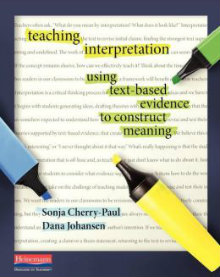Help Students Use Text-Based Evidence
Teaching Interpretation: Using Text-Based Evidence to Construct Meaning
By Sonja Cherry-Paul and Dana Johansen
(Heinemann, 2014 – Learn more)
 Reviewed by Linda Biondi
Reviewed by Linda Biondi
When reading a novel or watching a movie, we sometimes notice particular lines or phrases that stand out. “There’s no place like home” in The Wizard of Oz. Or “In spite of everything, I still believe people are really good at heart” from The Diary of Anne Frank. Or “It was a bright cold day in April, and the clocks were striking thirteen” in 1984.
 While reading the recent book by Sonja Cherry-Paul and Dana Johansen, Teaching Interpretation: Using Text-Based Evidence to Construct Meaning, the words that stood out to me were “readers bring themselves to a text.” (p. 85) Reading is not just turning pages to read words and glance at pictures; it’s a complicated task.
While reading the recent book by Sonja Cherry-Paul and Dana Johansen, Teaching Interpretation: Using Text-Based Evidence to Construct Meaning, the words that stood out to me were “readers bring themselves to a text.” (p. 85) Reading is not just turning pages to read words and glance at pictures; it’s a complicated task.
Once you learn how to navigate the task, it becomes automatic. However, before it can be automatic, our students need to be taught how to read complex texts, and one of the strategies for learning is “close reading.” Close reading brings the reader to the book, letting them slow down to notice, wonder and connect meaning.
Textual evidence has been and is the core of argument and analysis. In fact, most of the current Common Core ELA standards revolve around anchor standard 1: Textual evidence. To meet the standard, our students need explicit and consistent instruction in finding appropriate and valid textual evidence.
A perfect tool to promote close reading
As an educator, I seek out resources to help me guide my students towards being able to draft their theories and support them with textual evidence. Teaching Interpretation is a perfect fit for my classroom. It’s filled with innovative lessons that can be implemented immediately.
I applaud the authors for their wisdom and their honesty. They write:
We encourage you to use this book in the way that works best with your curriculum, teaching style, and students. It is not meant to replace a reading curriculum but rather can be molded to fit with the literacy work in your classroom. The mantra “Time is precious” is a reality for teachers. This book is designed for you to pull…ideas, lessons, assessments, and graphic organizers into the work you’re already doing.
These are wonderful, validating words.
Inside the book
All children need to learn to read critically, and Sonja Cherry-Paul and Dana Johansen show us how to make that happen. Each chapter begins with a scenario from one of the authors’ classrooms and a conversation about the background, rationale, and Common Core State Standards connection.
I loved the format of each chapter:
- Getting Ready – suggested pre-assessments
- Launching – explanations of the concept, discussion ideas, lessons and activities
- Identifying Text Evidence – strategies to help students locate and select textual evidence
- Sample Lesson – how might approach the instruction,
- Interpretation Framework Process – a short guide to where students might be in this process, helpful hints from the experts
- Looking Across Texts – commonalities and differences between texts and genres
- If…Try…Strategies for Novice and Advanced Readers – differential strategies you can apply
- Planning a Year of Teaching – teaching points that can be incorporated across the learning continuum
- Text Recs – QR codes for title, authors, and digital bins of resources (Search no more! It’s all here!)
- Resources – graphic organizers
Putting the authors’ ideas to the test
Just reading a recipe about baking a cake doesn’t make a cake. In order to “test” the material in a book, you need to use it before reviewing it. I used the suggestions in the chapter, “Mood, Atmosphere, and Tone” with my students.
I have to admit, my fourth grade students often amaze me with their thoughts and I have to stand back, smile, and say “I never thought of that before.” They are using analytical skills to make inferences, interpret data, organize ideas, and make connections.
This chapter took them a step further along their journey into close reading and interpretation. I used the document camera to post exemplar responses. The students enjoyed the fact that the examples were authentic – not provided by an author but in “kid language” because they were written by a student.
Another joy was the digital bins – digital text sets provided via the QR codes. I had never heard about digital bins before, so I decided to do a bit of sleuthing on the Web. I found the authors’ website, Litlearnact, which offers a wealth of information and resources. The resources are current, applicable to students in grades 3 through middle school, and captivating to the students because they can relate to them. Talk about big gifts in “little packages”!
I tried to think of a word that would define this book. I chose “mentor.” According to the Cambridge Dictionaries Online, a mentor is ”an experienced and trusted person who gives another person advice and help, especially related to work or school, over a period of time” That’s exactly what this book is – a mentor (text) that you can trust with your teaching and students.
My disappointments? None, except I wish I’d read this book in September.


































I just saw this review after enjoying my last day of spring break in beautiful weather relaxing and reading this book! It is definitely the best professional book of ’14-’15 thus far and I’m looking forward to more by these authors, or in similar vein,
But… I’m wondering about the myriad ways to balance this AWESOME interpretation work with teaching basic comprehension skills to students who still struggle with the anchor standard RL__.3 – getting the basic story elements and how they fit together. I believe in teaching high-level thinking work, and have plunged ahead with interpretation, lenses, and critical analysis but not dedicating as much time as I’d like, and sacrificing some to constant review lessons on character traits, character change, setting, etc. (in 7th grade, lots of students 3+ years behind…)
How do others teach, or envision teaching, with this much time dedicated to standard ___.4 while also accounting for the need to catch student up? (Assuming there’s no intervention time or centers/small group work time, which isn’t a great solution with over 50% of a class is struggling with the same thing…)